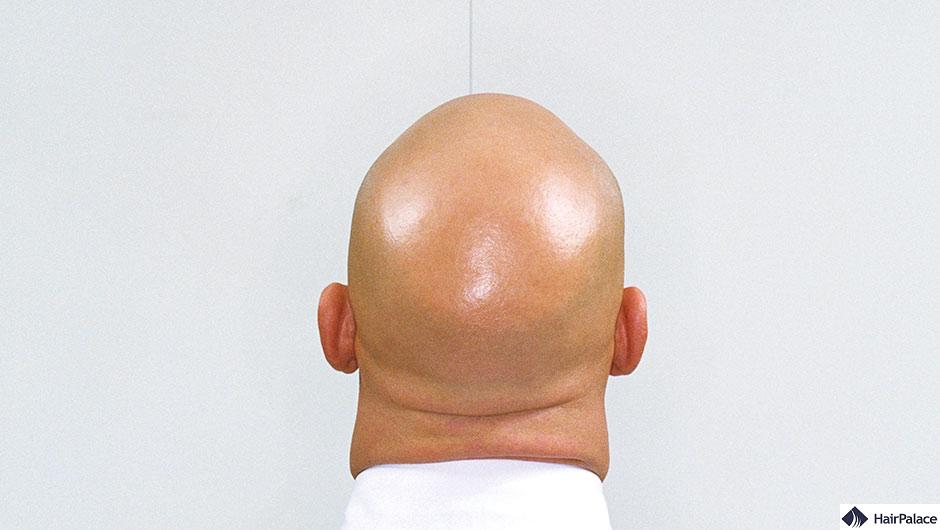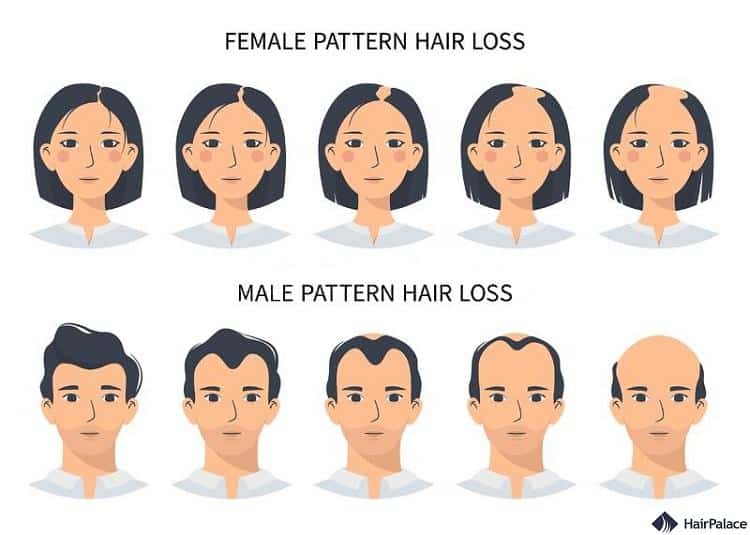Genetic Hair Loss: Is There a Baldness Gene?

Hair loss, a concern that transcends age and gender, often carries a significant emotional and psychological burden.
Genetic hair loss is a hereditary condition, most commonly manifesting in the shape of female or male pattern baldness.
It leads to gradual hair loss over time as the hairs get finer and weaker, which can result in complete baldness.
Could this condition be related to a specific hair loss gene?
We’ll unravel the genetic threads that contribute to this common condition, understand its progression, and evaluate both traditional and cutting-edge treatments available.
The baldness gene
Baldness, particularly hereditary hair loss, is strongly influenced by genetics. The condition is primarily associated with a combination of genetic and hormonal factors.
The most significant genetic factor is believed to be a human androgen receptor gene (or genes) passed down through the maternal line.
Although recent research suggests that the paternal line’s genetics also play a crucial role.
The key hormone involved in this type of baldness is dihydrotestosterone (DHT), which is a derivative of testosterone.
Genes that make certain individuals more sensitive to the effects of DHT can lead to hair follicles shrinking, resulting in thinner hair and eventual hair loss.
In some cases, this leads to a very early onset androgenetic alopecia, but most men tend to develop symptoms into their late thirties or even later.
It’s important to note that while the male baldness gene plays a major role, it’s not the sole factor.
Environmental factors, health conditions, and lifestyle choices can also influence hair loss.
What causes genetic hair loss?

The primary causes of hereditary hair loss in men and women are called male pattern hair loss and female pattern baldness respectively.
Male pattern baldness
This is what causes genetic hair loss in men in the vast majority of cases. Male pattern baldness, also known as androgenetic alopecia, is the most common type of hair loss in men.
It typically follows a characteristic pattern of receding hairline and thinning on the crown, often leading to a horseshoe-shaped hair ring around the head’s sides and back.
This condition affects a significant proportion of men at some point in their lives, with the likelihood increasing with age.
The pattern of hair loss in male pattern baldness is typically predictable.
It often starts with a receding hairline at the temples, followed by thinning on the top of the head causing partial or complete baldness.
The speed and pattern of hair loss vary greatly among individuals.
Some may experience rapid hair loss at a young age, while others might only have mild thinning later in life.
There’s currently no cure for male pattern baldness, but there are several ways to slow down or treat hair loss in some men.
Female pattern hair loss
Female pattern hair loss, also known as androgenetic alopecia in women, is a common condition characterized by thinning hair, primarily on the top and crown of the scalp.
Unlike male pattern baldness, female pattern hair loss usually involves a general thinning of the hair, maintaining the hairline.
The exact causes of female pattern hair loss aren’t completely understood. However, it’s believed to be related to a combination of genetic and environmental factors.
The role of androgens, which are male hormones present in smaller amounts in women, is also considered significant.
The onset and severity of female pattern hair loss can vary. It often begins after menopause, although it can start as early as puberty.
The condition is characterized by a widening of the part and sometimes noticeable thinning at the crown. Unlike male pattern alopecia, female hair loss rarely leads to complete baldness.
How common is the male pattern baldness gene in men?

The prevalence of the genetic predisposition to male pattern baldness, or androgenetic alopecia, is quite high among men, though the exact percentage can vary based on ethnicity and age.
It’s estimated that hair loss occurs in about 50% of all men by the time they reach 50, and there is an increased risk of suffering from hair disorders with every passing year.
The genetic factors involved in male pattern baldness are complex and not limited to a single gene.
Instead, it’s believed to be polygenic, meaning it involves multiple genes.
One of the most well-known genetic markers associated with this type of hair loss is found on the X chromosome, which men inherit from their mothers.
However, recent studies have shown that the father’s genetic contribution also plays a significant role.
The prevalence of these genetic markers varies among different populations.
For instance, male pattern baldness is more common in some ethnic groups than others.
It tends to be more prevalent among Caucasian men compared to African or Asian men.
Genetic hair loss symptoms
Symptoms vary slightly between men and women. Here’s an overview of these symptoms:
For Men:
- Receding Hairline: One of the earliest signs of male pattern baldness is a receding hairline, often starting at the temples and resembling an “M” shape.
- Thinning at the Crown: Thinning often begins at the crown (top) of the head, gradually progressing to baldness.
- Hair Miniaturization: Affected hair follicles gradually produce finer, shorter, and thinner hairs, a process known as miniaturization.
- Noticeable Hair Loss Over Time: Over time, the receding hairline and crown thinning may progress, leading to a horseshoe pattern of hair around the sides and back of the head.
For Women:
- General Thinning: Unlike men, women typically experience a general thinning of hair, particularly at the crown and parting line. The hairline usually does not recede.
- Widening Part: The part in the hair often becomes wider as the scalp becomes more visible.
- Reduced Volume: Overall hair volume reduces, and it may become more challenging to style hair to cover thinning areas.
- Ponytail Test: Women may notice a reduction in the circumference or thickness of their ponytail.
It’s important to note that these symptoms can vary from person to person. In some cases, hair loss may be more rapid and noticeable, while in others, it can be slow and subtle.
How to tell if hair loss is genetic or stress-related?
To determine if hair loss is genetic or stress-related, consider these factors:
- Pattern: It often shows a receding hairline and thinning at the crown in men, and overall thinning in women. Stress-related hair loss typically involves widespread thinning across the scalp.
- Onset and Duration: It is gradual and progressive over the years. Stress-related hair loss usually occurs suddenly, often a few months after a stressful event, and is often temporary.
- Family History: A family history of baldness suggests hereditary hair loss.
- Recent Stress or Illness: If hair loss follows a major stress or illness, it’s more likely stress-related.
Genetic hair loss in men treatment
Treatment involves a combination of medication, lifestyle changes, and in some cases, surgical options.
The most common treatments include:
- Minoxidil: This over-the-counter topical medication is applied to the scalp and can stimulate hair growth and slow the progression of hair loss.
- Finasteride: A prescription oral medication that can significantly slow down hair loss and even lead to regrowth in some men.
- Hair Transplant: This involves moving hair follicles from the back and sides of the head, where hair is denser, to the balding areas.
- Laser Therapy: LLLT devices, such as laser combs and helmets, may promote hair growth by stimulating the scalp and hair follicles with laser light.
- Scalp Micropigmentation: SMP is a cosmetic procedure that involves tattooing tiny dots on the scalp this is done to mimic the look of short hair follicles
- Living a healthy life: A balanced diet, regular exercise, and stress reduction can support overall health and potentially impact hair health.
FAQ
To help reduce genetic hair loss naturally, focus on maintaining a balanced diet rich in essential vitamins and minerals. Incorporate natural hair growth stimulants such as rosemary oil or peppermint oil into your hair care routine. Regular scalp massages can improve blood circulation. Additionally, practising stress-reducing activities like yoga and meditation can be beneficial. Avoid harsh hair treatments and heat styling to minimize damage. While these methods may help, results can vary from person to person.
Last medically reviewed on April 11th, 2025
- Schindl A, Schindl M, Pernerstorfer-Schon H, Schindl L. Low-intensity laser therapy: A review. J Investig Med. 2000;48(5):312–326. https://pubmed.ncbi.nlm.nih.gov/10979236/
- Hamilton JB. Patterned loss of hair in man; types and incidence. Ann. N. Y. Acad. Sci. 1951;53(3):708–728.https://pubmed.ncbi.nlm.nih.gov/14819896
- Olsen EA. Disorders of Hair Growth: Diagnosis and Treatment. McGraw-Hill, Medical Pub. Division; 2003.
- Nyholt DR, Gillespie NA, Heath AC, Martin NG : Genetic basis of male pattern baldness. J Invest Dermatol 2003; 121: 1561–1564.http://scholar.google.com/scholar_lookup?&title=Genetic%20basis%20of%20male%20pattern%20baldness&journal=J%20Invest%20Dermatol&doi=10.1111%2Fj.1523-1747.2003.12615.x&volume=121&pages=1561-1564&publication_year=2003&author=Nyholt%2CDR&author=Gillespie%2CNA&author=Heath%2CAC&author=Martin%2CNG
- Ho CY, Chen JY, Hsu WL, Yu S, Chen WC, Chiu SH, Yang HR, Lin SY, Wu CY. Female Pattern Hair Loss: An Overview with Focus on the Genetics. Genes (Basel). 2023 Jun 23;14(7):1326. doi: 10.3390/genes14071326. PMID: 37510231; PMCID: PMC10379895.https://pubmed.ncbi.nlm.nih.gov/37510231/


